brakes BUICK PARK AVENUE 1993 Owners Manual
[x] Cancel search | Manufacturer: BUICK, Model Year: 1993, Model line: PARK AVENUE, Model: BUICK PARK AVENUE 1993Pages: 340, PDF Size: 18.17 MB
Page 83 of 340
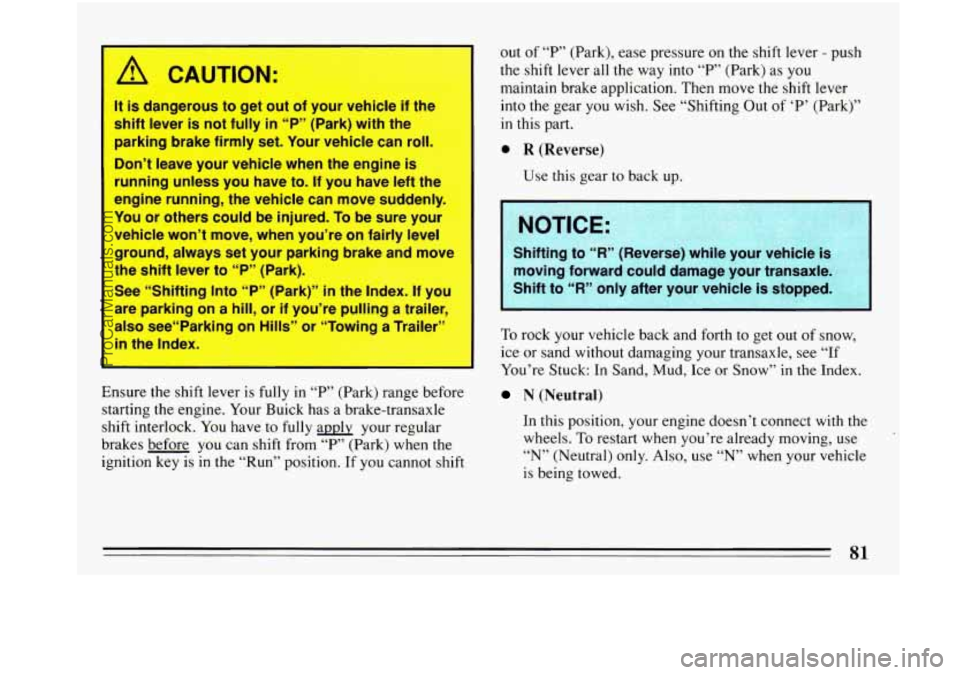
I A CAUTION:
It is dangerous to get out of your vehicle if the
shift lever is not fully
in “P” (Park) with the
parking brake firmly set. Your vehicle can roll.
Don’t leave your vehicle when the engine is
running unless you have to.
If you have left the
engine running, the vehicle can move suddenly.
You or others could be injured. To be sure your
vehicle won’t move, when you’re on fairly level
ground, always set your parking brake and move
the shift lever to “P” (Park).
See “Shifting Into “P” (Park)”
in the Index. If you
are parking on a
hill, or if you’re pulling a trailer
also see“Parking on Hills” or “Towing a Trailer’
in the Index.
Ensure the shift lever is fully in “P” (Park) range before
starting the engine. Your Buick has a brake-transaxle
shift interlock. You have
to fully apply your regular
brakes before you can shift from “P” (Park) when the
ignition key is in the “Run” position. If you cannot shift out
of
“P” (Park), ease pressure on the shift lever - push
the shift lever all the way into
“P” (Park) as you
maintain brake application. Then move the shift lever
into the gear you wish. See “Shifting Out
of ‘P’ (Park)”
in this part.
0 R (Reverse)
Use this gear to back up.
Shifting to ‘W’ (Reverse) while your vehicle is
moving forward could damage your transaxle.
Shift to
“R” only after your vehicle is stoppc
To rock your vehicle back and forth to get out of snow,
ice or sand without damaging your transaxle, see
“If
You’re Stuck: In Sand, Mud, Ice or Snow” in the Index.
N (Neutral)
In this position, your engine doesn’t connect with the
wheels.
To restart when you’re already moving, use
“N” (Neutral) only. Also, use “N” when your vehicle
is being towed.
ProCarManuals.com
Page 84 of 340
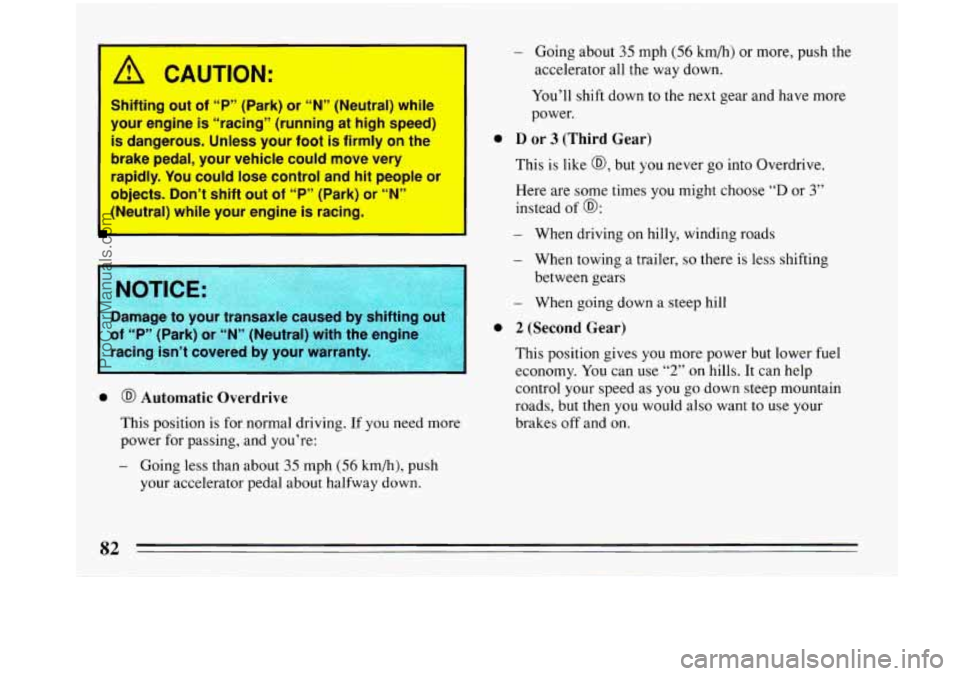
I
A CAUTION:
Shifting out of “PYy (Park) or “N” (Neutral) while
’ your engine is “racing” (running at high speed)
is dangerous. Unless your foot
is firmly on the
brake pedal, your vehicle could move very
rapidly. You could lose control and hit people or
objects. Don’t shift out of “P” (Park) or “N”
I (Neutral) while your engine is racing.
Damage to your tia,lsaxI
Going about 35 mph (56 km/h) or more, push the
accelerator all the way down.
You’ll shift down
to the next gear and have more
power.
0 D or 3 (Third Gear)
This is like @, but you never go into Overdrive.
Here are some times you might choose
“D or 3”
instead of @:
- When driving on hilly, winding roads
- When towing a trailer, so there is less shifting
between gears
- When going down a steep hill
0 2 (Second Gear)
This position gives you more power but lower fuel
economy. You can use
“2” on hills. It can help
control your speed as
you go down steep mountain
roads, but then you would also want to use your
brakes off and on. 0 @ Automatic Overdrive
This position is for normal driving. If you need more
power for passing, and you’re:
- Going less than about 35 mph (56 km/h), push
your accelerator pedal about halfway down.
82
ProCarManuals.com
Page 85 of 340
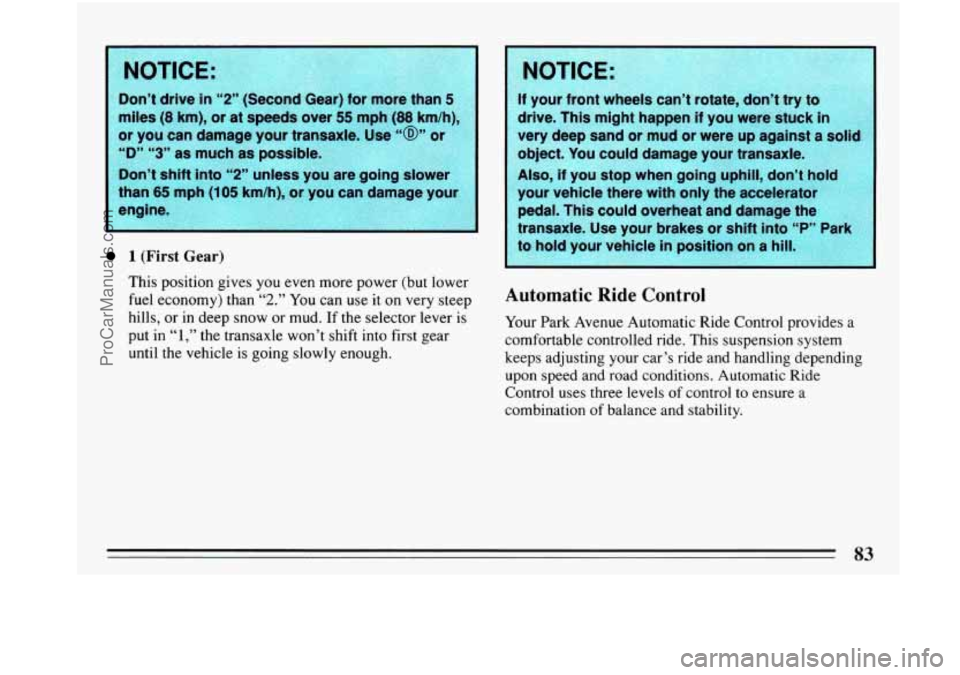
NOTICE: , * _. s*, ?x-&.
Don’t drive in “2” (Second Gear) for more than 5
miles (8 km), or at speeds over 55 mph (88 - km/h),
or you can damage your transaxle. Use
“@” 01
“D” “3” as much as possible
Don’t shift
into “2” unless you are going slower
than
65 mph (105 km/h), or you can damage your
1 (First Gear)
This position gives you even more power (but lower
fuel economy) than “2.” You can use it on very steep
hills, or in deep snow
or mud. If the selector lever is
put in
“1,” the transaxle won’t shift into first gear
until the vehicle is going slowly enough.
NOTICE:
If your front wheels can’t rotate, don’t try to
drive. This might happen if you were stuck in
very deep sand or mud or were up against a solid
object.
You could damage your transaxle.
Also, if you stop when going uphill, don’t hoW
your vehicle there with only the accelerator
pedal. This could overheat and damage
th
transaxle. Use your brakes or shift intc ‘‘D
to hold your vehicle in position on a
Automatic Ride Control
Your Park Avenue Automatic Ride Control provides a
comfortable controlled ride. This suspension system
keeps adjusting your car’s ride and handling depending
upon speed and road conditions. Automatic Ride
Control uses three levels
of control to ensure a
combination
of balance and stability.
83
ProCarManuals.com
Page 86 of 340
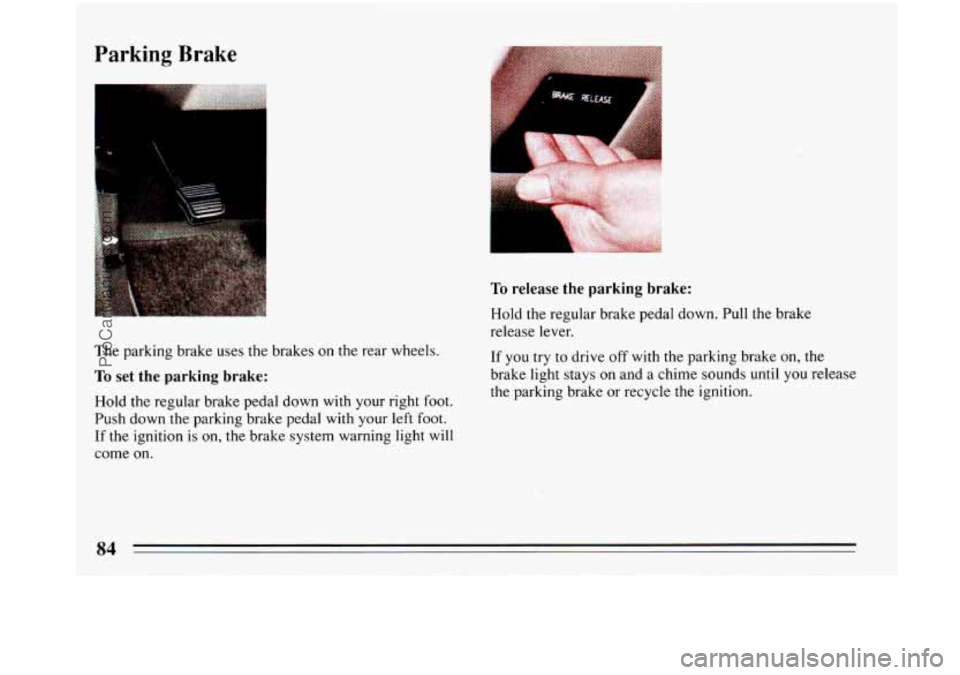
Parking Brake
The parking brake uses the brakes on the rear wheels.
To set the parking brake:
Hold the regular brake pedal down with your right foot.
Push down the parking brake pedal with your
left foot.
If the ignition
is on, the brake system warning light will
come on.
To release the parking brake:
Hold the regular brake pedal down. Pull the brake
release lever.
If you try to drive off with the parking braKe on, the
brake light stays on and a chime sounds until
you release
the parking brake or recycle the ignition.
ProCarManuals.com
Page 87 of 340
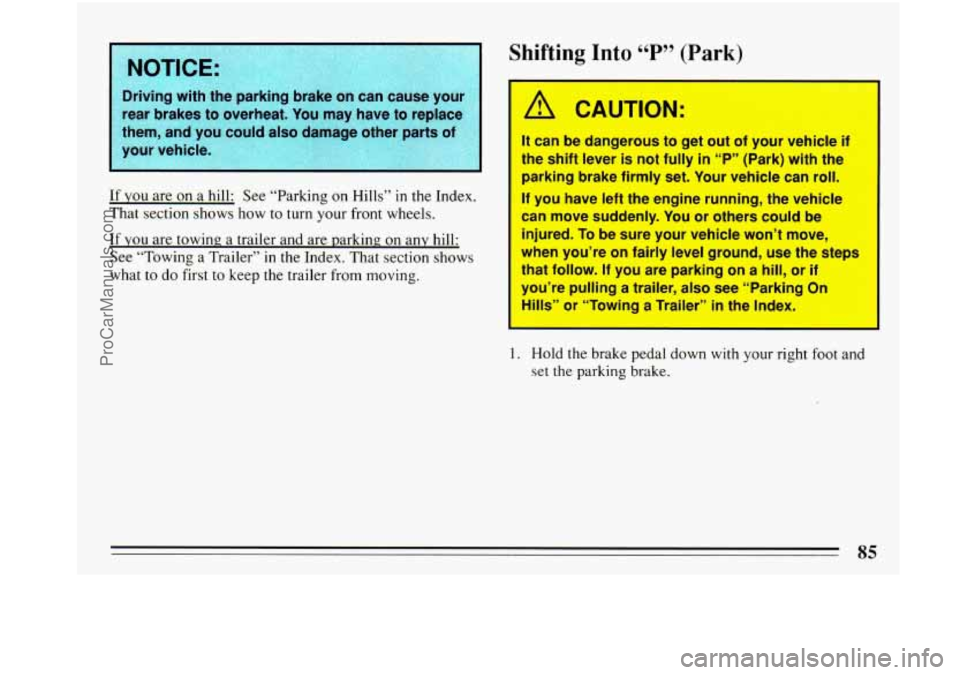
Driving with the parking brake on can cause youkz.,--.I
rear brakes to overheat.
You may have to replace-
them, and you could also damage other parts of
If YOU are on a hill: See “Parking on Hills” in the Index.
That section shows how to turn your front wheels.
If you are towing a trailer and are parking on any hill:
See “Towing a Trailer”
in the Index. That section shows
what
to do first to keep the trailer from moving.
Shifting Into “P” (Park)
A CAUTION:
It can be dangerous to get out of your vehicle if
the shift lever is not fully in “P” (Park) with the
parking brake firmly set. Your vehicle can roll.
If you have left the engine running, the vehicle
can move suddenly. You or others could be
injured. To be sure your vehicle won’t move,
when you’re on fairly level ground, use the steps
that follow.
If you are parking on a hill, or if
you’re pulling a trailer, also see “Parking On
H”‘ ;” or “Towing a Trailer” in the Index.
1. Hold the brake pedal down with your right foot and
set
the parking brake.
ProCarManuals.com
Page 98 of 340
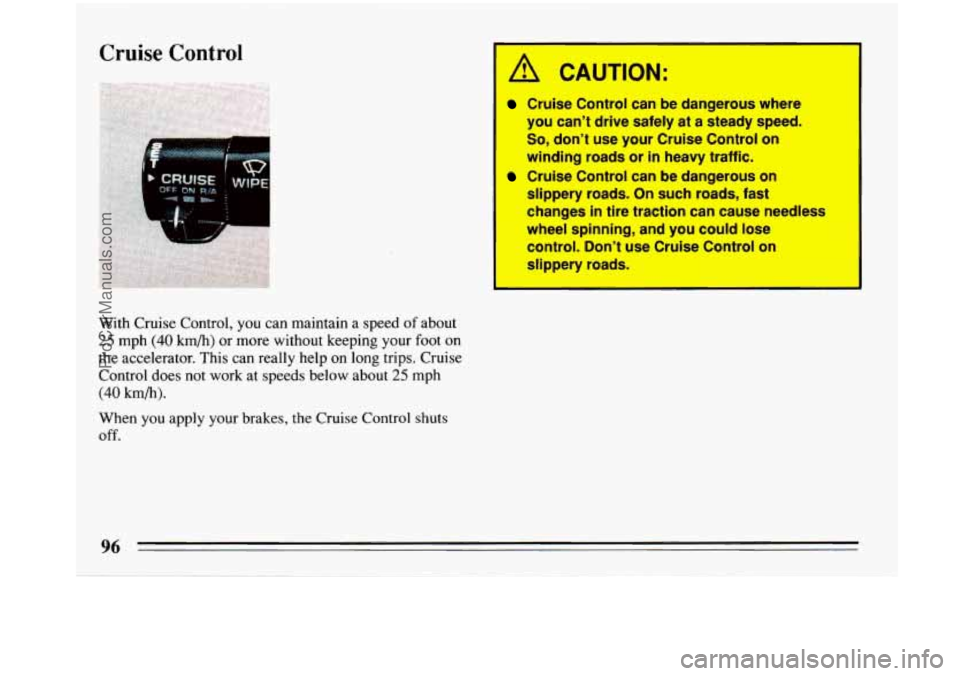
Cruise Control
L .. . .
With Cruise Control, you can maintain a speed of about
25 mph (40 km/h) or more without keeping your foot on
the accelerator. This can really help on long trips. Cruise
Control does not work at speeds below about
25 mph
(40 km/h).
When you apply your brakes, the Cruise Control shuts
off.
A CAUTION:
Cruise Control can be dangerous where
you can't drive safely
at a steady speed.
So, don't use your Cruise Control on
winding roads or in heavy traffic.
Cruise Control can be dangerous on
slippery roads. On such roads, fast
changes
in tire traction can cause needless
wheel spinning, and you could lose
control. Don't use Cruise Control on
slippery roads.
ProCarManuals.com
Page 122 of 340
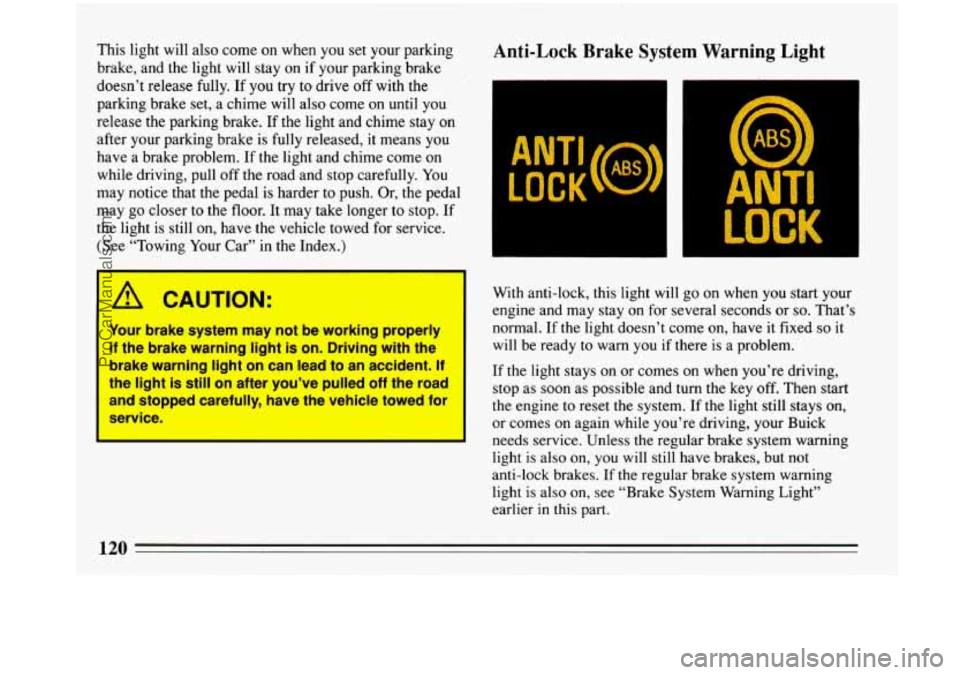
This light will also come on when you set your parking
brake, and the light will stay on if your parking brake
doesn’t release fully. If
you try to drive off with the
parking brake set, a chime will also come
on until you
release the parking brake. If the light and chime stay on
after your parking brake is fully released, it means
you
have a brake problem. If the light and chime come on
while driving, pull
off the road and stop carefully. You
may notice that the pedal is harder to .push. Or, the peda
may go closer to the floor. It may take longer
to stop. If
the light
is still on, have the vehicle towed for service.
(See “Towing Your Car” in the Index.)
I -
A CAUTION:
Your brake system may not be working properly
if the brake warning light is on. Driving with the
brake warning light on can lead to an accident.
If
the light is still on after you’ve pulled off the road
and stopped carefully, have the vehicle towed for
service.
1
Anti-Lock Brake System Warning Light
With anti-lock, this light will go on when you start your
engine and may stay on for several seconds or
so. That’s
normal. If the light doesn’t come on, have it fixed
so it
will be ready to warn
you if there is a problem.
If the light stays
on or comes on when you’re driving,
stop as soon as possible and turn the key
off. Then start
the engine
to reset the system. If the light still stays on,
or comes on again while you’re driving, your Buick
needs service. Unless the regular brake system warning
light
is also on, you will still have brakes, but not
anti-lock brakes.
If the regular brake system warning
light
is also on, see “Brake System Warning Light”
earlier
in this part.
ProCarManuals.com
Page 123 of 340

The anti-lock brake system warning light may also come
on when you are driving with a compact spare tire. If
this happens, the light means you won’t have anti-lock
until you replace the compact spare with a full-size tire.
If the warning light stays on after you replace the
compact spare
with a full-size tire, or if it comes on
again when
you’re driving, your Buick needs service.
Traction Control System Warning Light
(Option)
I The “TRACTION OFF”
warning light means that
the system is not working.
This warning light may
come on for the following
reasons:
If your transaxle overheats, the traction control
system automatically shuts off for about three minutes.
The warning light will come on and stay on
during that time.
If your brakes overheat, the traction control system
will
go off and the warning light will come on until
your brakes cool down.
If the “TRACTION OFF” warning light comes on and
stays on
for an extended period of time, your vehicle
needs service.
A CAUTION:
1 If you let your tires spin at high speed when the
“TRACTION
OFF” warning light is on, they can
explode and you or others could be injured. And,
spinning your tires with the “TRACTION
OFF”
warning light on can cause the transaxle to
overheat or can cause other problems. That
could cause an engine fire or other damage.
When you’re stuck, spin the wheels as little as
possible. Don’t spin the wheels above
35 mph
(55 km/h) as shown on the speedometer.
I
121
ProCarManuals.com
Page 172 of 340
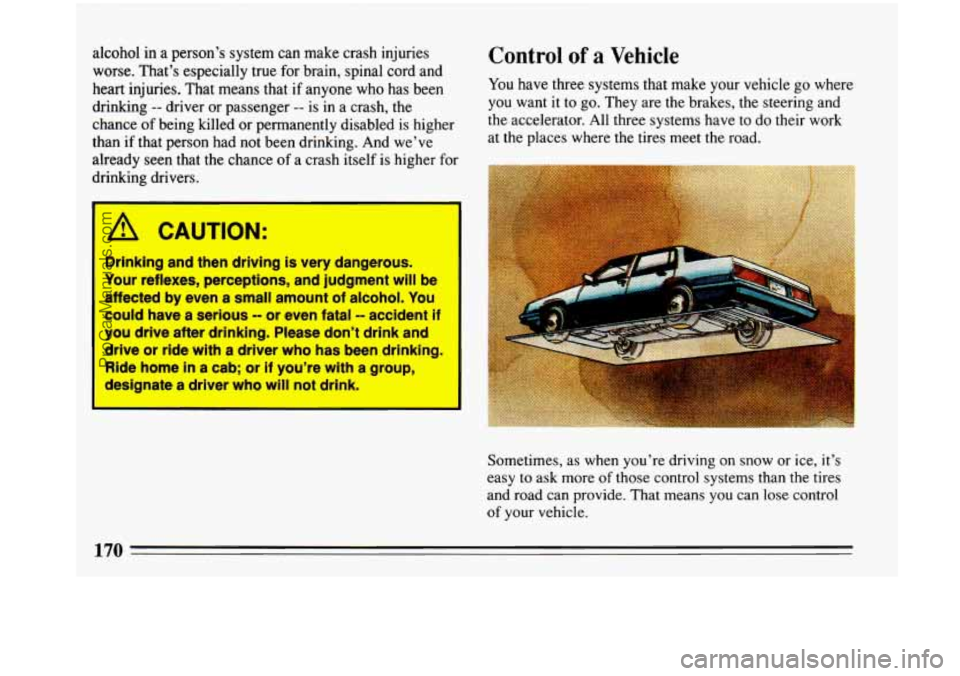
alcohol in a person’s system can make crash injuries
worse. That’s especially true for brain, spinal cord and
heart injuries. That means that if anyone who has been
drinking
-- driver or passenger -- is in a crash, the
chance of being killed or permanently disabled is higher
than if that person had not been drinking. And we’ve
already
seen that the chance of a crash itself is higher for
drinking drivers.
/I CAUTION:
Drlnklng and then driving Is very dangerous.
Your reflexes, perceptions, and judgment wlll be
affected by even a small amount of alcohol. You
could have a serious - or even fatal - accident if
you drive after drinking. Please don’t drink and
drive or rlde with a driver who has been drinking.
Ride home in a cab; or if you’re with a group,
designate a driver who will not drink
Control of a Vehicle
You have three systems that make your vehicle go where
you want it to go. They are the brakes, the steering and
the accelerator. All three systems have to do their work
at
the places where the tires meet the road.
Sometimes, as when you’re driving on snow or ice, it’s
easy
to ask more of those control systems than the tires
and road can provide. That means you can lose control
of your vehicle.
ProCarManuals.com
Page 173 of 340
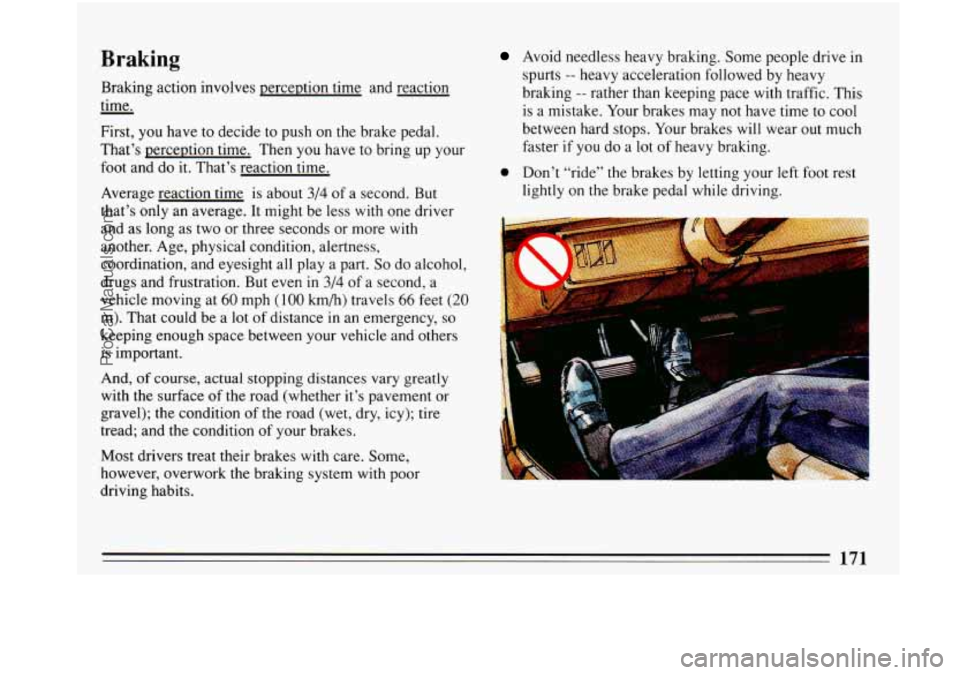
Braking
Braking action involves perception time and reaction
- time.
First, you have to decide to push on the brake pedal.
That’s perception time. Then you have to bring up your
foot and do it. That’s reaction time.
Average reaction time
is about 3/4 of a second. But
that’s only an average. It might be less with one driver
and as long as two or three seconds or more with
another. Age, physical condition, alertness,
coordination, and eyesight all play a part.
So do alcohol,
drugs and frustration. But even in 3/4 of a second, a
vehicle moving at
60 mph (100 km/h) travels 66 feet (20
m). That could be a lot of distance in an emergency, so
keeping enough space between your vehicle and others
is important.
And,
of course, actual stopping distances vary greatly
with the surface of the road (whether it’s pavement or
gravel); the condition
of the road (wet, dry, icy); tire
tread; and the condition
of your brakes.
Most drivers treat their brakes with care.
Some,
however, overwork the braking system with poor
driving habits.
Avoid needless heavy braking. Some people drive in
spurts
-- heavy acceleration followed by heavy
braking
-- rather than keeping pace with traffic. This
is a mistake. Your brakes may not have time to cool
between hard stops. Your brakes will wear out much
faster if you
do a lot of heavy braking.
0 Don’t “ride’’ the brakes by letting your left foot rest
lightly on the brake pedal while driving.
a==-- . . -.
ProCarManuals.com